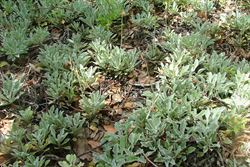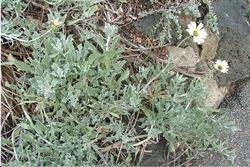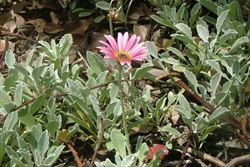Click on images to enlarge

mass garden planting (Photo: Sheldon Navie)

habit (Photo: Sheldon Navie)

deeply lobed greyish-coloured leaves (Photo: Sheldon Navie)

the upper leaves are sometimes almost entire (Photo: Sheldon Navie)

flower-head (Photo: Sheldon Navie)

the purple-flowered form of this species (Photo: Sheldon Navie)
Scientific Name
Arctotis stoechadifolia P.J. Bergius
Synonyms
Arctotis venusta Norl. (misapplied)
Family
Asteraceae (Queensland, New South Wales, the ACT, Victoria, Tasmania, Western Australia and the Northern Territory)Compositae (South Australia)
Common Names
African daisy, arctotis, aurora daisy, silver arctotis, trailing daisy, white arctotis
Origin
Native to south-western Africa (i.e. Cape Province in South Africa).
Naturalised Distribution
Widely naturalised in southern Australia, particularly in coastal districts (i.e. in south-western Western Australia, south-eastern SA and on Kangaroo Island, in southern Victoria and in Tasmania). Also present in the coastal and sub-coastal districts of northern and central New South Wales and in inland southern Queensland.
Notes
This garden escape is regarded as an environmental weed in Victoria, South Australia and Western Australia. It is an important weed of coastal sand dunes in south-eastern South Australia, where it forms dense mats that smother native dune vegetation and eliminate indigenous plants through shading and competition for resources. White arctotis (Arctotis stoechadifolia) can also alter the dune structure and cause dunes to develop a steeper slope. It is regarded as a priority environmental weed in the Henley South and West Beach Dune Reserve in Adelaide and is also present in other coastal conservation areas in this area (e.g. Hallett Cove Conservation Park and Scott Creek Conservation Park).
White arctotis (Arctotis stoechadifolia) is also spreading from plantings as a sand stabilizer and dumped garden rubbish into coastal dunes between Jurien Bay and Busselton in south-western Western Australia. For example, it occurs in large patches in semi-protected areas between and behind the primary dunes on the foreshore at Cambridge. Similarly, in Victoria it is a weed of dune shrublands and is among the list of the top 40 environmental weeds of the Geelong region.

